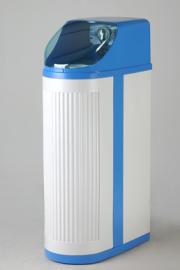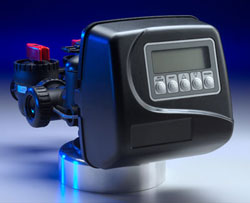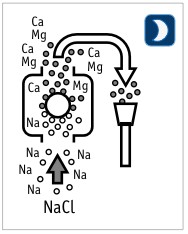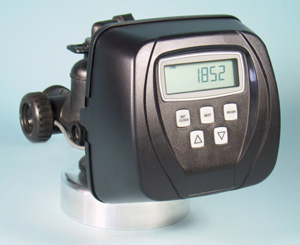Domestic softeners
 |
The limescale in the water pipes in the house, pans, sinks, shower enclosures is the result of the precipitation of calcium dissolved in the water, in the form of calcium carbonate. Water softeners are the only devices that physically remove limescale to reject to sewer: calcium ions are removed from water by ion exchange. |
Advantages
- Protection against scaling pipes, plumbing fixtures and electrical appliances
- Yield maintenance of fixtures to normal levels
- Economical and ecological solution, which reduces the excessive use of cleaning products
- Softer linens and dishes without traces
- Recommended for the proper functioning of jacuzzis, steam rooms, ...
Operation
n water softening, water passes through a selective ion exchange resin. This resin absorbs calcium (Ca) and magnesium (Mg) in water (hardness) and replaces them with sodium (Na), from sodium chloride (NaCl = "table salt"). Periodically, the resin is regenerated automatically replacing Ca and Mg with Na ions.

Regeneration - two choices
To as the passage of water, the resins become saturated with calcium and magnesium. Then water softener requires a "regeneration", during which the resin is recharged with sodium and a concentrated solution of calcium and magnesium is sent to the sewer.
This regeneration is automatically triggered at regular intervals (eg, every 4 days) for chronometric softeners. But it may also activate a function of the consumption of water, which is measured by a counter, for volumetric softeners. Most of the facilities provided by ozone.ch combine both properties (chronometric + volumetric).
Chronometric softenerResin regeneration is automatically activated following the time, for fixed periods during the night. The number of days between two regenerations is programmed during the commissioning of the softener, depending on your water usage and water hardness. |
|
|
Volumetric softener with microprocessorThe regeneration is triggered automatically during the night, in advance, depending on the water consumption, which is measured by a counter incorporated in the head of the softener, and the amount of softened water available. Its benefits, compared with the chronometer model are permanently available softened water and save water: regeneration is only triggered when the resin is actually exhausted. |
Volumetric valve CLACK |
The choice of a softener
The dimensioning of the softener varies depending on the water consumption. We offer several standard sizes in the table below. If none of these dimensions for your application, also ozone.ch offers customized softeners with integrated or separate brine tank.
|
Size in liters of resin |
Maximum flow recommended in m3 / h |
Adapted for |
| 5 | 1.0 | Water for a machine (washing machine, for example), studio, small cottage. |
| 12 | 2.5 | Apartment, cottage, house occupied by 2 people. |
| 18 | 2.5 | House occupied by 3-4 people, low water consumption. |
| 25 | 3.0 | Family home occupied by at least 4 people and rather high water consumption. |
| 30 | 3.5 | Large family home, building with 2-3 apartments. |
| 25 – double* | 3.0 | Building with 3-4 apartments, large houses with very high consumption. Situations that require the ability to have softened water continuously round the clock. |
| 35 – double* | 3.5 | Building with 5-6 apartments. Situations that require the ability to have softened water continuously round the clock. |
| 60 – 75 – 150 | depending on model | Buildings, hotels, restaurants |
*:Two columns are used to provide continuous soft water; a working while the other is regenerated.
 |
 |
| Softener with integrated brine tank | Softener with separate brine tank |
Accessories
- Particulate filter that protects the resin softener against impurities of water: rust, sand, etc.
- Automatic chlorinator to disinfect the resin.
- When the softener has no automatic chlorification option, it is mandatory to disinfect the resin at least once every 3 months in order to limit the development of micro-organisms.
- Double bacteriological safety of the water with a UV sterilizer
The reasons for the use of a home water softener
In Switzerland, as elsewhere, the water quality is not always equal from one region to another or from a neighboring town to another. In water, is often found the presence of limescale called "hard water", is characterized by its concentration of calcium ions and / or magnesium is what makes scale-forming.
Conversely, a "soft water" has few of these ions.
The problem of limescale in water
- Hard deposits and scaling in pipes
- Reduction of the life of the fixtures
- Development of limescale
How to measure hardness ?
It's possible to measure the quality of the water in order to qualify the "hard water" or "soft water". The total hardness or "TH" expresses the water hardness by measuring the amount of calcium salts and / or magnesium.
Before you have the water in an approved testing laboratory, tests are possible and easily realizable to determine the hardness of the water.
 |
Use of test strips They provide information on the hardness of the water on contact. Soaked in water, the strip changes color from one to four segments and signals that the water is soft, medium soft, medium and hard. |
 |
Use of a liquid reagent The liquid reagent colors the water. The number of drops so that the water is colored, indicates the "TH". |
Your advantages with ozone.ch
Company partner of DLK Technologies SA, we can offer you a wide range of domestic and industrial water softeners, from the USA for the "Top Quality" either from Italy for the "Top Prize". It goes without saying that the installation and service are "Swiss made".
In addition, ozone.ch provides :
- Turnkey delivered and installed systems;
- Necessary staff training and technical assistance;
- Laboratory analysis;
- Service and maintenance contracts.



